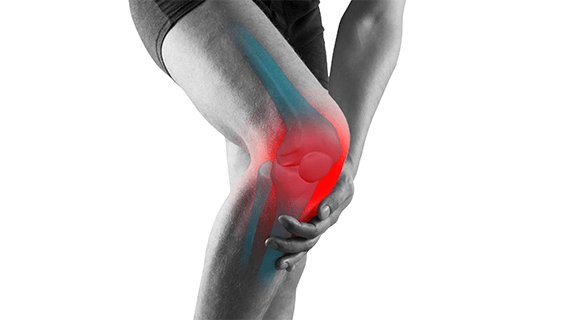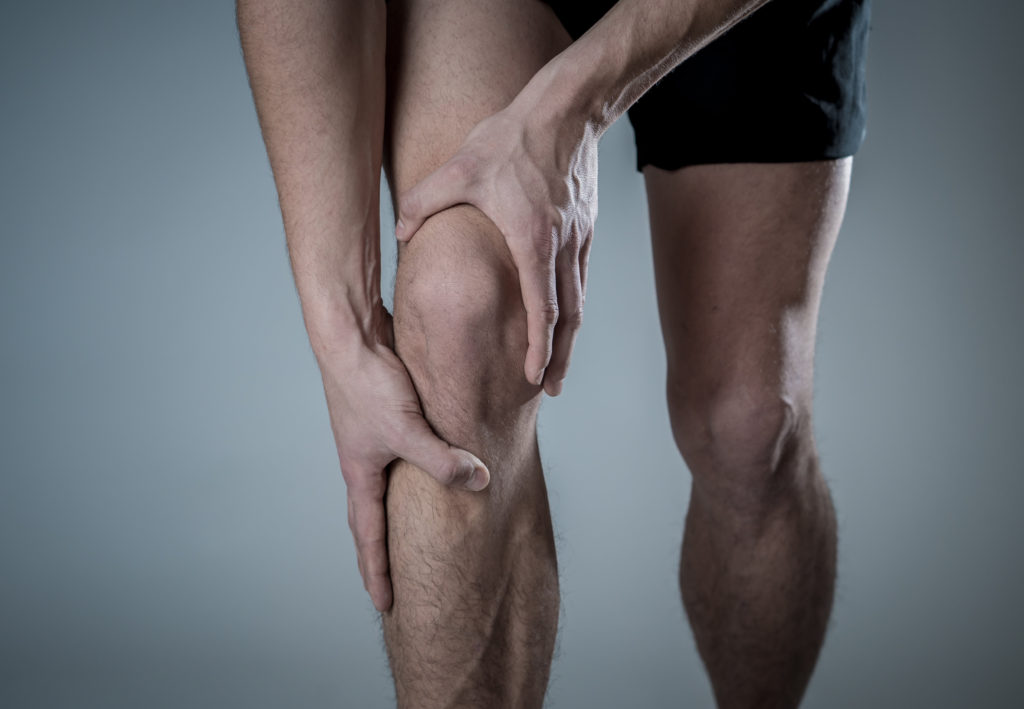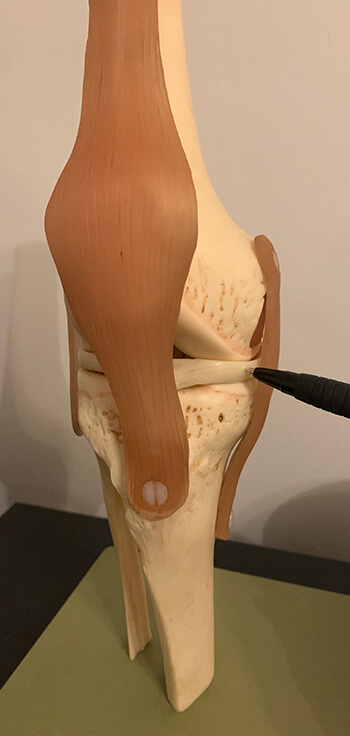Knee Pain Manchester
Knee pain is a common symptom among adults, typically after the age of 35. It is most often associated with wear and tear due to daily activities, such as walking, standing, bending, and lifting. People who regularly play sports that require jumping, running, or quick pivoting are more prone to experiencing knee pain and other knee problems.
Whether the root cause is an injury or merely ageing, knee pain can result in great discomfort and interfering with your everyday activities. After all, the knee is one of the largest and most complex joints in the human body. To understand and knee pain, need understand its anatomy and structure.


Our knee consists of the femur (thighbone), the patella (kneecap), the tibia (shinbone), cartilage, ligaments, and tendons. The knee joint consists of the femur joining the tibia and fibula. Meanwhile, tendons and ligaments connect the knee bones to the muscles that make the knee joint move.
In the majority of cases, minor knee pain responds well to self-care measures. In addition to this, knee braces or physical therapy can help relieve pain as well.
Home care treatment for knee pain involves the RICE principle : Resting the knee, Icing the knee (or cold therapy), Compressing the knee and Elevating the knee.
It is also important to protect the knee from further trauma and to use over-the-counter pain killer medications for temporary relief.
In severe cases, however, you will need to contact a professional for an assessment. Physicians that specialise in treating knee pain can evaluate the exact cause of the problem and devise treatment plans accordingly.
Causes And Symptoms Of Knee Pain
Symptoms of knee pain can vary from person to person, depending on the severity of the injury. Most importantly, the cause of your knee pain dictates how the pain feels.
Knee pain can result from a wide number of causes or underlying conditions. Let’s discuss a few of the most prominent causes of knee pain, along with their symptoms.
1. Osteoarthritis
Osteoarthritis is one of the leading causes of knee pain in adults. It occurs when the cartilage that forms the cushion between the bones and joints gradually begins to degenerate. The cartilage is a firm slippery tissue that enables frictionless joint movement in our body. If your cartilage deteriorates, the bone will often start to rub together, resulting in knee pain.
Older age, obesity, joint injuries, repeated stress on the joints, genetics, bone deformities, and certain metabolic diseases increase your risk of osteoarthritis.
In addition to this, women are more likely to develop osteoarthritis compared to men.

Symptoms of Knee Pain due to Osteoarthritis
- Pain in the knee joint.
- Joints appear swollen and larger in size especially with weather changes.
- Crackling sensation and sound on bending or straightening the knee
- Limited Movement.
- Muscle loss in the thigh and feeling of weakness when getting up from a chair
2. Runner’s Knee (Patellofemoral Pain Syndrome or IT Band Syndrome)
If you are experiencing pain at the front of your knee or around the knee cap, there is a high chance you are suffering from the runner’s knee. Generally, women and older people are more likely to develop a runner’s knee as compared to men and children. Here is a list of things that increase your risk of developing a runner’s knee:
If you are experiencing pain at the front of your knee or around the knee cap, there is a high chance you are suffering from the runner’s knee. Generally, women and older people are more likely to develop a runner’s knee as compared to men and children. Here is a list of things that increase your risk of developing a runner’s knee:

- Jumping or running sports that put repetitive stress on the knee cap can irritate the knee cap.
- When the muscles around the hip area and the knee area are not aligned properly, it results in muscle imbalance in the hip and thigh muscles resulting in patella maltracking. This results in premature ‘softening’ or ‘wearing away’ of the cartilage under the knee cap
- Injury to the knee cap, such as fracture or dislocation.
- Knee surgery, particularly one associated with the anterior cruciate ligament that uses the patellar tendon as a graft.
Symptoms of Knee Pain due to Runner’s Knee
- A sensation of pain in and around the kneecap when engaging in sports or similar activities.
- Pain in knees if they are bent for a long time while sitting.
- Clicking sound on bending or straightening the knee.
- Tender kneecap.
3. Bursitis

Bursitis is another common cause of knee pain, particularly in individuals suffering from obesity. This occurs due to the inflammation of small fluid-filled sacs, called bursa, located near your knee joint. This fluid sac acts as a cushion between your bones and tendons along with muscles and skin to reduce friction during movement.
- Sustaining pressure on the knees for an extended period of time from kneeling on hard surfaces.
- Strenuous activities.
- Knee encountering a direct blow.
- Infected bursa.
- Complications from rheumatoid arthritis, osteoporosis, or gout in your knee.
Symptoms of Knee Pain due to Bursitis
- Pain and Stiffness around the knee.
- The knee aches and hurts more when touched.
- Visibly swollen and red knee.
4. Baker’s Cyst
- Inflammation of the knee joint due to various types of arthritis.
- Experiencing a knee injury, such as a Cartilage tear.
Symptoms of Knee Pain due to Baker’s Cyst
- Formation of fluid-filled lump behind the knee.
- A sensation of pain in the knees.
- Stiffness around the knee.
- Limited ability to bend the knee.
- Visibly swollen knee and sometimes the whole leg which may be mistaken for a DVT
5. Ligament Tear (e.g. ACL Tear)

- Slowing down suddenly and changing direction (cutting).
- Awkward landing from a jump.
- Suddenly stopping.
- A collision where the knee receives a direct blow, such as a tackle during football.
Symptoms of Knee Pain due to Ligament Tear
- The sensation of pain is sudden and severe.
- A loud pop during the injury.
- Knee gets swollen within the first 24 hours of the injury.
- The joint feels loose/unstable
6. Meniscus Tear
The meniscus is a piece of cartilage that acts as a cushion between your thigh bone and your shin bone. Any activity that causes you to forcefully rotate or twist your knee, such as suddenly stopping, turning, or pivoting aggressively, can result in a torn meniscus.
Hence the meniscus can be described as the shock absorber of the knee
Even lifting something heavy, deep squatting, or kneeling can sometimes cause a tear in your meniscus. In older adults, however, degenerative changes in the knee can lead to a meniscus tear without any trauma or injury.
Symptoms of Knee Pain due to Meniscal Tear
- Pain in the knee joint.
- Swollen knee
- The knee joint is locked and hence immovable.
- Inability to weightbear and limping when you walk
- Giving way or ‘locking’ of the knee when you bend or straihghten the knee

7. Patellar Tendinitis

Patellar Tendinitis occurs due to repeated stress on your patellar tendon, resulting in the formation of micro tears or degeneration of the Patella tendon. Although your body tries to repair these micro tears, they often tend to multiply, eventually weakening and inflaming the tendons.
If the tendon damage lasts more than a few weeks or months, it results in patellar tendinitis. Physical activity, tight leg muscles, muscular imbalance, certain Antibiotics and chronic illness disrupting blood flow to the knee can cause patellar tendinitis.
Symptoms of Knee Pain due to Patellar Tendinitis
- Experiencing pain in tendons that gets worse as you move.
- Crackling sensation on moving the joint.
- Swelling accompanied by a sensation of heat.
- Inability to run or jump without pain which eases with rest
8. Osteochondral Defects
The osteochondral defect is a serious joint condition that occurs when there is a defect in the cartilage or bone in the knee joint. Often there may be a pierce of cartilage or bone missing in ther joint or even ‘floating’ in the joint. The causes of this defect are often trauma or secondary to wear and tear. Genetic factor plays a major role in this as well.
Symptoms of Knee Pain due to Osteochondral Defects
- Slight pain in the knee joint, especially when pressure is applied.
- Moderate movement problems.
- Total loss of cartilage can cause bones to grind together, resulting in severe pain.
- Swelling and inflammation.
- The area feels warm with slight redness.
- Fever or increased body temperature due to the body’s attempt to fight infection in the area.
- Catching and locking of the knee joint.
9. Post Knee Replacement Pain
Symptoms of Post Knee Replacement Pain

- Reduced range of function and motion.
- Inability to put pressure on the knee.
- Scratching or popping sound on moving the knee.
- Pain during movement or physical activity.
- Swelling around the joint.
- Feeling as though the knee will ‘give out’ while walking, standing, or climbing stairs.
10. Referred Knee Pain from Hip or Foot Problems:
Although it may seem strange, knee pain is often the first and only symptom of any hip related problem. In people with arthritis, referred knee pain can often cause a delay in the diagnosis of a hip problem. In addition to hip problems, your referred pain may also be caused by problems in the feet.
Referred pain is not exactly the same as radiating pain. Radiating pain tends to travel along an identifiable path, i.e., from point A to B. On the other hand, referred pain seems to come from the place it is being felt. In this case, the knee pain seems to be originating from the knee, however, the real cause lies in the hip or foot.
Symptoms of Referred Knee Pain from Hip or Foot Problems
- Tingling and prickling sensations in the hip area.
- Sudden sharp sensations in the hip area.
- Reduced range of movement.
- Inability to walk in the usual way causing you to limp at times.
Diagnosis of Knee Pain
In order to suggest appropriate treatment, it is necessary to first identify the exact cause of your knee pain. Typically, a diagnosis begins by enquiring about the general health of the patient and then moving towards the nature of the knee pain, such as severity, duration and nature of the pain.
Here at the MyMSK Clinic we do the following to determine the exact cause of your knee pain:

Physical Examination
After taking a history, we conduct a thorough physical exam of the knee. This step includes bending the knee through the full range for evaluation of motion and checking for swelling and tenderness. Comparing the painful knee with the other knee helps in the process of diagnosis as well. Mostly, this is all that is required for a professional to diagnose and start treatment.
Ultrasound
In case physical examination fails to identify the exact cause of the pain, an ultrasound scanner is often used to help diagnose the problem. It is usually helpful for inspecting the bursa, the fluid-filled knee cavity. Here at MyMSK Clinic, we have an in-house Ultrasound facility for our patients.
X-ray, MRI, CT Scan
In case ultrasound can not identify the exact cause of your knee pain, we use imaging tests like X-ray or an MRI scan. At MyMSK Clinic, we can refer our patients for X-rays or MRI scans if needed.
Treatment of Knee Pain
Once we have successfully diagnosed the exact cause of your knee pain, the next step is to devise an appropriate treatment plan.
Here at MyMSK Clinic, we specialise in all the latest treatment options for knee pain.
Here are the primary treatment options we offer to our patients to manage their knee pain depending on its cause and severity.
1. Osteopathy
Osteopathy care is an excellent treatment options for individuals suffering from knee pain. Osteopathy looks at the human body in a holistic way rather than a sum of individual organs. This treatment aims at finding the root cause of the knee pain rather than offering a temporary solution. It uses physical manipulation, massage, and stretching in order to:
- Increase the mobility of joints.
- Relieve muscle tension.
- Help the body to heal naturally.
- Enhance blood supply to tissues.
Similarly, Osteopathy is based on the theory that our body functions best when our spine is aligned correctly, benefiting our muscles and joints. It is a form of manual therapy in which practitioners use special instruments and hands to deliver treatment.
Here, at MyMSK, we treat our patients with the latest osteopathy techniques to relieve knee pain and associated problems.

2. Injections
i. Cortisone
ii. Platelet Rich Plasma (PRP)
The platelets in our blood contain growth and regeneration factors. Platelet-Rich Plasma (PRP) is a treatment for managing pain in the joints due to osteoarthritis (OA).
It allows us to harness these growth factors for treating several muscle and joint problems. Injecting PRP into the injured area enables tissues to repair themselves by forming new cells. In this way, it helps to reverse existing tissue damage and heal injured areas.
PRP is a fairly simple and effective treatment option for knee pain. First, the doctor will draw a small amount of blood from your arm. Afterwards, the blood sample is put into a centrifuge to separate the components and extract a concentrated suspension of platelets. After this, the doctor simply numbs your knee and injects PRP into the joint space. After resting for a little while, you may go home.
iii. Hyaluronic Acid
iv. Prolotherapy
Prolotherapy is an effective treatment option for individuals suffering from musculoskeletal injuries or pain problems. It has been used by practitioners to treat knee pain for more than 75 years. Prolotherapy works by raising growth factors to promote tissue repair and growth within the body to relieve pain.
The core principle of prolotherapy is to inject small volumes of an irritant solution at multiple ligaments, tendon insertions, and in adjacent joint spaces over the course of several treatment sessions. This irritant initiates the inflammatory process that results in increased collagen synthesis and ultimately stimulates growth. With this method we are trying to get the knee to kick start a process of regeneration
When Should I Consult a Doctor?
Typically, small injuries to the knee can be seen to with self-care or home treatment.
However, in case of major injury or persistent pain, it is best to visit a Professional.
Well, if you are living in Manchester or Burnley and searching for an experienced Osteopath, MyMSK clinic is a good option.
MyMSK clinic is a CQC regulated clinic which maintains the highest of treatment standards
Here at MyMSK Clinic, we listen to your problems and carefully craft treatment plans for your knee pain. Our aim is to offer quality and effective treatment solutions for individuals who suffer from back, muscular, and joint pain.
Our Specialist, Dr. Amir Akhtar, focuses on providing the a quality service to his patients. Dr Akhtar is a GMC registered practitioner, and GOSc registered Osteopath. He is amongst only a handful of practitioners in the UK who are certified in this way.
He deals with Muscle and Joint pain, Spinal Injections, and Prolotherapy (Spinal and Peripheral Joints). If you are struggling with knee pain, you can book an appointment with Dr Akhtar directly by filling the contact form or reach us through telephone or email.
Final Thoughts on Knee Pain
Knee pain is one of the most common causes of distress among adults. It can occur due to multiple reasons, including injury, trauma, osteoarthritis, bursitis, runner’s knee, Patellar Tendinitis, Osteochondral defect, etc. Depending on the severity of the knee pain, you may experience symptoms according to the underlying cause.
Typically, small injuries to the knee can be treated by simple home treatment remedies or self-care techniques.
However, in case of major injury or persistent pain, it is best to visit a professional Osteopath for an in-depth check-up. If you have been suffering from knee pain, feel free to contact the MyMSK clinic in Manchester and Burnley for an in-depth examination. Our experienced clinicians will help you diagnose the exact cause of your pain and suggest an appropriate treatment plan.
Frequently Asked Questions (FAQs)
Normally, our cartilage is responsible for lubricating the knee joint and keeping the kneecap stable. You may experience knee pain while descending the stairs if your cartilage is damaged, allowing the kneecap to slide out of position. Now, this may happen due to regular wear & tear, degeneration, or an injury. If you are experiencing knee pain when walking downstairs, it’s most likely that you are suffering from Patellofemoral Pain Syndrome, Chondromalacia Patella, or Osteoarthritis.
Treatments

Joint Injections
Combined with rehab program, joint injection treatments at MyMSK Clinic show exciting and promising results
Explore More
Cortisone Injections
A Cortisone Injection (termed steroid injection in the UK) is an anti inflammatory injection for the joints or body tissue to relieve pain.
Explore More
Platelet Rich Plasma
PRP treatment can reduce the need for anti-inflammatory medication or strong painkillers with unwanted side effects
Explore More
Prolotherapy
A regenerative treatment for chronic painful joints and ligaments which involves the injection of a specially formulated solution into damaged tissue.
Explore More
Hyaluronic Acid
At MyMSK Clinic, we tend to offer Hyaluronic Acid injections(Durolane or Ostenil Plus) for Joint Pain and Osteoarthritis.
Explore MoreFor a detailed assessment of your Knee Pain
Contact us
We’d love to hear from you!
Just reach out and contact us via any of
these channels:

Call us on

Email us on

Call us on





